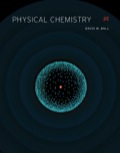
Concept explainers
(a)
Interpretation:
The number of photons generated each second from a
Concept introduction:
The term Laser is the abbreviation for “Light Amplification by Stimulated Emission of Radiation”. The laser gives light after the amplification process. The energy of light after the amplification process is so high that this device can be used to cut a thick metal sheet.
(b)
Interpretation:
The conversion of
Concept introduction:
The term Laser is the abbreviation for “Light Amplification by Stimulated Emission of Radiation”. The laser gives light after the amplification process. The energy of light after the amplification process is so high that this device can be used to cut a thick metal sheet.
Want to see the full answer?
Check out a sample textbook solution
Chapter 15 Solutions
EBK PHYSICAL CHEMISTRY
- A particular transition of the rubidium atom emits light whose frequency is 3.84 1014 Hz. (Hz is the abbreviation for hertz, which is equivalent to the unit/s, or s1.) Is this light in the visible spectrum? If so, what is the color of the light? (See Figure 7.5.)arrow_forwardA ruby laser puts out a pulse of red light at a wavelength of 694 nm. (The ruby laser is described in the essay on p 226.) If a pulse delivers 1.05 105 watts of power for 280 s, how many photons are there in this pulse? (1 watt = 1 J/s.)arrow_forwardAn FM radio station broadcasts at a frequency of 101.3 MHz. What is the wavelength, in meters and nanometers, of this radiation?arrow_forward
- Calculate the energy per mole of photons for the laser used in Blu-ray players ( = 405 nm)arrow_forwardCalculate the energy per mole of photons (in kJ/mol) for red light with a wavelength of 700 nm. Calculate the energy per mole of photons (in kJ/mol) for UV-B light with a wavelength of 300 nm. How many times more energetic is this UV-B than this red light?arrow_forwardAnswer the following questions about a Blu-ray laser: (a) The laser on a Blu-ray player has a wavelength of 405 nm. In what region of the electromagnetic spectrum is this radiation? What is its frequency? (b) A Blu-ray laser has a power of 5 millwatts (1watt=1Js1). How many photons of light are produced by the laser in 1 hour? (c) The ideal resolution of a player using a laser (such as a Blu-ray player), which determines how close together data can be stored on a compact disk, is determined using the following formula: Resolution =0.60(/NA), where A is the wavelength of the laser and NA is the numerical aperture. Numerical aperture is a measure of the size of the spot of light on the disk; the larger the NA, the smaller the spot. In a typical Blu-ray system, NA = 0.95. If the 405-nm laser is used in a Blu-ray player, what is the closest that information can be stored on a Blu-ray disk? (d) The data density of a Blu-ray disk using a 405-nm laser is 1.5107 bits mm2. Disks have an outside diameter of 120 mm and a hole of 15-mm diameter. How many data bits can be contained on the disk? If a Blu-ray disk can hold 9,400,000 pages of text, how many data bits are needed for a typed page? (Hint: Determine the area of the disk that is available to hold data. The area inside a circle is given by A=r2, where the radius r is one-half of the diameter.)arrow_forward
- 6.9 If a string of decorative lights includes bulbs with wave-lengths of 480, 580, and 700 mm, what are the frequencies of the lights? Use Figure 6.6 to determine which colors are in the set.arrow_forwardAn FM radio station found at 103.1 on the FM dial broadcasts at a frequency of 1.031188s1 (103.1 MHz). What is the wavelength of these radio waves in meters?arrow_forwardRadio waves in the AM region have frequencies in the range 530 to 1700 kilocycles per second (530 to 1700 kHz). Calculate the wavelength corresponding to a radio wave of frequency 1.460 106/s (that is, 1460 kHz).arrow_forward
- Which photons contain more energy, X-ray photons with a frequency of 31017 Hz or ultraviolet photons with a frequency of 21015 Hz? X-ray photons Ultraviolet photons Neither. They both contain the same energy per photon.arrow_forward(a) Ozone formation in the upper atmosphere starts when oxygen molecules absorb UV radiation of wavelengths ≤ 242 nm. Find the frequency and energy of the least energetic of these photons. (b) Ozone absorbs radiation of wavelengths 2200–2900 Å, thus protecting organisms from this radiation. Find the frequency and energy of the most energetic of these photons.arrow_forwardHello, i need assistance in following the attached image. Thank you!!arrow_forward
 General Chemistry - Standalone book (MindTap Cour...ChemistryISBN:9781305580343Author:Steven D. Gammon, Ebbing, Darrell Ebbing, Steven D., Darrell; Gammon, Darrell Ebbing; Steven D. Gammon, Darrell D.; Gammon, Ebbing; Steven D. Gammon; DarrellPublisher:Cengage Learning
General Chemistry - Standalone book (MindTap Cour...ChemistryISBN:9781305580343Author:Steven D. Gammon, Ebbing, Darrell Ebbing, Steven D., Darrell; Gammon, Darrell Ebbing; Steven D. Gammon, Darrell D.; Gammon, Ebbing; Steven D. Gammon; DarrellPublisher:Cengage Learning Chemistry: The Molecular ScienceChemistryISBN:9781285199047Author:John W. Moore, Conrad L. StanitskiPublisher:Cengage Learning
Chemistry: The Molecular ScienceChemistryISBN:9781285199047Author:John W. Moore, Conrad L. StanitskiPublisher:Cengage Learning Chemistry & Chemical ReactivityChemistryISBN:9781337399074Author:John C. Kotz, Paul M. Treichel, John Townsend, David TreichelPublisher:Cengage Learning
Chemistry & Chemical ReactivityChemistryISBN:9781337399074Author:John C. Kotz, Paul M. Treichel, John Townsend, David TreichelPublisher:Cengage Learning Chemistry: Principles and PracticeChemistryISBN:9780534420123Author:Daniel L. Reger, Scott R. Goode, David W. Ball, Edward MercerPublisher:Cengage Learning
Chemistry: Principles and PracticeChemistryISBN:9780534420123Author:Daniel L. Reger, Scott R. Goode, David W. Ball, Edward MercerPublisher:Cengage Learning
 Chemistry for Engineering StudentsChemistryISBN:9781337398909Author:Lawrence S. Brown, Tom HolmePublisher:Cengage Learning
Chemistry for Engineering StudentsChemistryISBN:9781337398909Author:Lawrence S. Brown, Tom HolmePublisher:Cengage Learning





